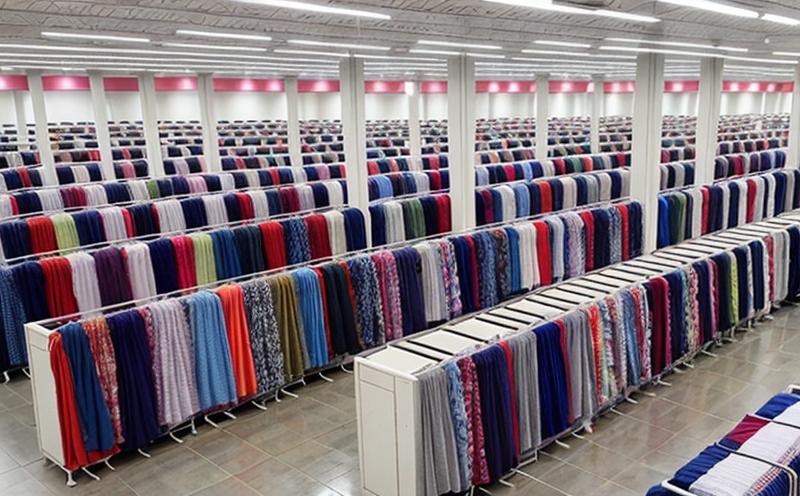ISO 5084 Thickness Measurement Testing of Fabrics in Trade
The ISO 5084 standard is a crucial benchmark for fabric thickness measurement, widely recognized and utilized across various sectors including government trade facilitation testing. This service focuses on the detailed application of ISO 5084 to measure the thickness of fabrics, ensuring compliance with international standards and facilitating seamless trade.
Fabric thickness is a critical factor in determining the quality, durability, and performance of textiles used in export. This measurement ensures that exported products meet the required specifications set by importing countries, thereby promoting fair trade practices. The ISO 5084 standard provides uniformity and consistency in fabric thickness measurements, which are essential for both buyers and sellers.
The first step in this process is to select the appropriate specimen for testing. Specimens should be representative of the fabric type and size suitable for the test. Preparing these specimens involves ensuring they are free from defects or irregularities that could affect the accuracy of the measurement. Once prepared, the fabric samples are placed on a precision thickness gauge designed specifically for ISO 5084 compliance.
The testing procedure itself is straightforward but requires meticulous execution to achieve accurate results. The specimen is carefully aligned with the measuring surface of the instrument, and the thickness is recorded at multiple points across the sample. Multiple measurements ensure that any variability within the fabric is accounted for, providing a comprehensive understanding of the fabric’s thickness characteristics.
Reporting the results involves compiling all measurement data into a detailed report. This report should include the average thickness value along with standard deviation to illustrate the consistency and uniformity of the fabric. The report should also highlight any areas of concern or discrepancies that could affect the quality or performance of the fabric in the market.
The importance of ISO 5084 compliance cannot be overstated, especially within government trade facilitation contexts. By adhering to this standard, businesses can ensure their exported textiles meet international quality standards, thereby enhancing customer trust and satisfaction. Compliance also facilitates smoother trade processes by reducing the likelihood of disputes over product specifications.
For those involved in R&D or quality management, ISO 5084 provides a robust framework for developing new fabrics that meet global market demands while ensuring consistency across different production batches. This standard is particularly valuable in sectors where fabric thickness can significantly impact the performance and longevity of products, such as apparel manufacturing.
In summary, ISO 5084 Thickness Measurement Testing ensures that textile exports comply with international standards, promoting fair trade practices and enhancing product quality. By leveraging this service, companies can ensure their exported fabrics are accurately measured, thus meeting global market expectations and maintaining a competitive edge in the international trade landscape.
Applied Standards
| Standard Number | Description |
|---|---|
| ISO 5084:2017 | Specification for thickness measurement of fabrics |
| ASTM D3776-18 | Standard test methods for measuring the thickness of textile fabrics and articles by average cross-sectional area method |
The application of ISO 5084 in trade facilitation is complemented by other relevant standards such as ASTM D3776. These standards provide additional methods and criteria to ensure comprehensive fabric thickness measurement, thereby enhancing the accuracy and reliability of testing results.
Scope and Methodology
| Methodology Steps | Description |
|---|---|
| Sample Preparation | Ensure specimens are representative of the fabric type and size suitable for testing. |
| Measurement Alignment | Align the specimen precisely with the measuring surface of the instrument. |
| Data Recording | Record thickness values at multiple points across the sample. |
The methodology for ISO 5084 testing involves several critical steps. Initially, the fabric specimens are prepared to ensure they are representative of the fabric type and size suitable for testing. This preparation ensures that any irregularities or defects do not influence the accuracy of the measurement.
Once prepared, the specimens are placed on a precision thickness gauge designed specifically for ISO 5084 compliance. The gauge is aligned with the specimen to ensure accurate measurements. Thickness values are recorded at multiple points across the sample to account for any variability within the fabric. This comprehensive approach ensures that the test results accurately reflect the fabric’s thickness characteristics.
The final step involves compiling all measurement data into a detailed report. This report should include the average thickness value along with standard deviation, illustrating consistency and uniformity in the fabric. Any areas of concern or discrepancies are highlighted to provide insights into potential quality issues that could affect product performance or market acceptance.
Use Cases and Application Examples
- Quality Control: Ensuring consistent fabric thickness across production batches for high-quality exports.
- Product Development: Utilizing accurate measurements to enhance product design and performance.
- Compliance Verification: Confirming that exported fabrics meet international quality standards and regulatory requirements.
- Demand Mapping: Understanding market preferences by analyzing fabric thickness data from different regions.
ISO 5084 Thickness Measurement Testing is particularly useful in various sectors, including government trade facilitation. In this context, the service ensures that exported textiles comply with international standards, promoting fair trade practices and enhancing product quality. The accurate measurement of fabric thickness helps to ensure consistent performance across different production batches, thereby maintaining a competitive edge in the global market.
For quality managers and compliance officers, ISO 5084 provides a robust framework for developing new fabrics that meet global market demands while ensuring consistency across different production batches. This standard is particularly valuable in sectors where fabric thickness can significantly impact the performance and longevity of products, such as apparel manufacturing.





